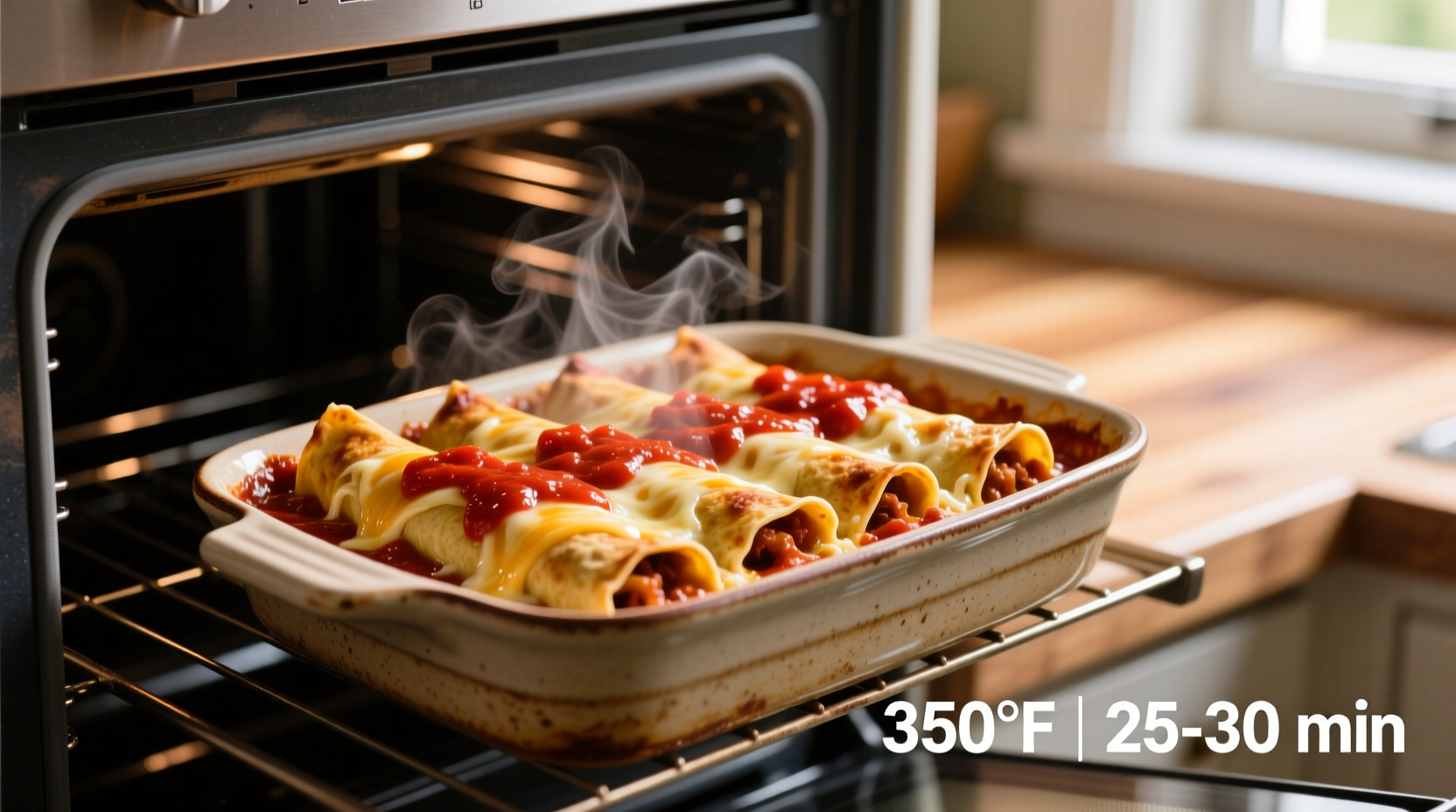Enchiladas should be baked at 350°F for 20-25 minutes until the internal temperature reaches 165°F and the sauce is bubbling around the edges. This timing applies to most traditional cheese, chicken, or beef enchiladas in a standard 9x13 inch baking dish.
The Perfect Timing for Perfect Enchiladas
Getting your enchiladas just right requires more than just following a timer. While 20-25 minutes at 350°F works for most standard enchilada recipes, several factors determine whether your dish will emerge perfectly cooked or disappointingly underdone. Let's explore what really matters when baking this beloved Mexican classic.
Why 350°F Is the Sweet Spot for Enchiladas
Professional kitchens and home cooks alike have settled on 350°F as the ideal temperature for baking enchiladas. This moderate heat allows the filling to heat through without drying out the tortillas or burning the sauce. Higher temperatures risk scorching the edges while leaving the center cold, while lower temperatures can make tortillas soggy as they absorb too much sauce before heating through.
| Enchilada Type | Recommended Time | Internal Temp | Visual Cues |
|---|---|---|---|
| Cheese enchiladas | 20-22 minutes | 160°F | Sauce bubbling, cheese melted |
| Chicken enchiladas | 22-25 minutes | 165°F | Edges slightly browned, steam rising |
| Beef enchiladas | 23-26 minutes | 165°F | Sauce thickened, meat fully heated |
| Vegetable enchiladas | 18-22 minutes | 160°F | Veggies tender, sauce bubbling |
Four Critical Factors That Change Your Cooking Time
Understanding these variables will help you adjust timing for perfect results every time:
1. Filling Composition Matters Most
Meat-based fillings require longer cooking than cheese or vegetable versions. The USDA Food Safety and Inspection Service recommends cooking poultry to 165°F for safety, which means chicken enchiladas need that extra 2-3 minutes compared to cheese varieties. For reference, the USDA's safe minimum cooking temperatures provide clear guidelines for all protein types.
2. Sauce Consistency Affects Baking Time
Thicker sauces (like mole) conduct heat differently than thinner red or green sauces. Enchiladas with watery sauces may need an additional 3-5 minutes as the liquid evaporates. If you've ever wondered why your enchiladas seem undercooked despite following timing instructions, sauce thickness is likely the culprit.
3. Dish Material Changes Heat Distribution
Glass and ceramic dishes retain heat longer than metal, potentially requiring 2-3 minutes less cooking time. Professional test kitchens at America's Test Kitchen found that metal pans transferred heat 15% faster than ceramic equivalents, significantly impacting final cooking time.
4. Oven Accuracy Is Often Overlooked
Many home ovens run 25-50 degrees hotter or cooler than displayed. Using an oven thermometer (like those recommended by Consumer Reports) ensures your 350°F setting is actually 350°F. This simple tool prevents countless cooking disasters by verifying your oven's true temperature.

Your Step-by-Step Baking Process
Follow these precise steps for enchiladas that emerge perfectly cooked every time:
Preparation Phase
Assemble your enchiladas in a lightly greased baking dish, covering them completely with sauce. For extra protection against drying, many Mexican grandmothers (abuelas) recommend a light sauce layer beneath the enchiladas too. This traditional technique, documented in Diana Kennedy's authoritative Cuisines of Mexico, prevents tortillas from sticking and drying out.
Baking Timeline
- 0-10 minutes: Initial heating phase where sauce begins to warm through
- 10-18 minutes: Critical period when heat penetrates to the center
- 18-22 minutes: Sauce starts bubbling around edges (key visual indicator)
- 22-25 minutes: Final setting phase where flavors meld completely
Doneness Check Protocol
Don't rely solely on the clock. Use this three-point verification system:
- Temperature check: Insert thermometer into center - 165°F for meat fillings
- Visual inspection: Sauce should bubble consistently around edges
- Texture test: Tortillas should be tender but hold shape when served
Troubleshooting Common Baking Issues
Even experienced cooks encounter problems. Here's how to fix them:
Soggy Bottom Enchiladas
Cause: Insufficient preheating or too much sauce
Solution: Bake uncovered for first 15 minutes, then cover loosely with foil
Dry or Tough Tortillas
Cause: Overbaking or insufficient sauce coverage
Solution: Reduce time by 3-5 minutes and ensure complete sauce coverage
Unheated Center
Cause: Oven temperature too low or dense filling
Solution: Increase temperature to 365°F and extend time by 5 minutes
Resting and Serving for Best Results
Resist the urge to serve immediately! Let enchiladas rest for 5-7 minutes after baking. This crucial step allows:
- Liquid redistribution throughout the dish
- Filling to set for cleaner slicing
- Flavors to fully integrate
Professional chefs at Mexico City's renowned El Cardenal restaurant insist this resting period transforms good enchiladas into exceptional ones.
Storage and Reheating Guidelines
Properly stored enchiladas maintain quality for 3-4 days in the refrigerator. For best reheating results:
- Cover with damp paper towel when microwaving
- Add 1-2 tablespoons broth when reheating in oven
- Reheat to 165°F internal temperature











 浙公网安备
33010002000092号
浙公网安备
33010002000092号 浙B2-20120091-4
浙B2-20120091-4